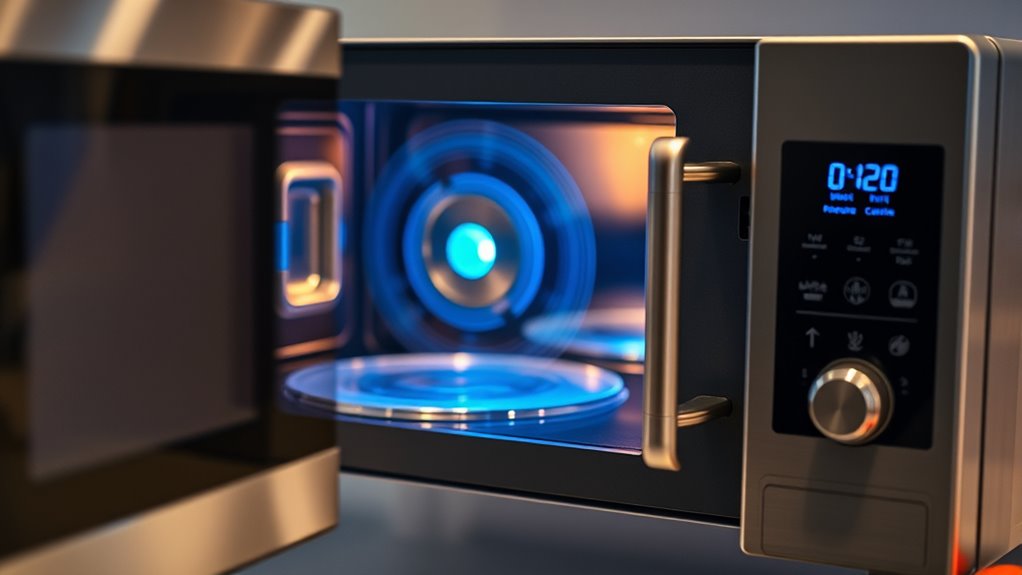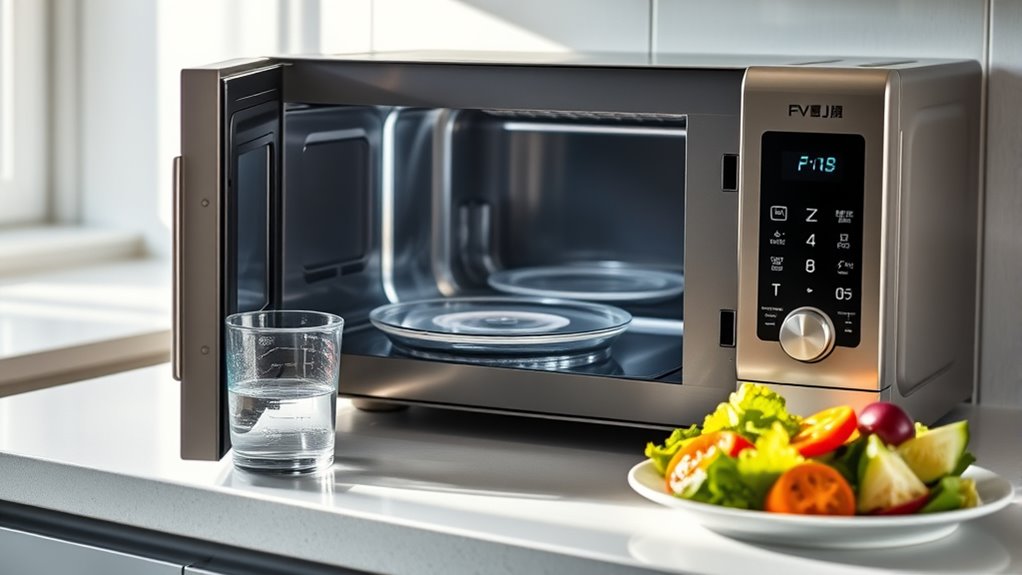Microwave radiation from your kitchen appliance isn’t dangerous when used properly. It’s a type of non-ionizing radiation that heats water molecules in food, not harmful ionizing radiation like X-rays. Safety standards and shielding prevent leaks, making risks minimal. Common myths about radiation causing harm are false, especially if you use microwave-safe containers. Want to understand more about the science behind microwave safety? Keep exploring to separate facts from myths.
Key Takeaways
- Microwave radiation is non-ionizing, meaning it cannot remove electrons or cause DNA mutations.
- Proper shielding and safety standards prevent harmful microwave radiation leakage during typical use.
- Microwave ovens heat food by energizing water molecules, not by making food radioactive or dangerous.
- High exposure levels can cause thermal burns, but everyday use remains safe when appliances are used correctly.
- Myths about microwaves causing cancer or genetic damage are unsupported by scientific evidence.
Understanding Microwave Radiation and Its Effects

Have you ever wondered what microwave radiation actually is and how it affects your body? Microwaves are a type of non-ionizing radiation, meaning they lack the energy to remove electrons from atoms, unlike X-rays. They primarily cause heating by energizing water molecules, which can lead to tissue warming at high exposure levels—this can cause burns or cataracts. Proper shielding is important when working with high-powered microwave sources to minimize exposure risks.
In medical fields, microwaves are used for imaging and tumor detection, highlighting their controlled, beneficial applications. Today, we’re exposed to microwaves through countless devices, but everyday household exposure is generally safe.
Researchers continue studying potential biological risks, especially with high-powered sources. Overall, understanding microwave radiation helps you see that, in normal use, it’s not inherently dangerous but warrants cautious handling at high intensities.
Common Myths About Microwave Safety

Many common beliefs about microwave safety are myths that can cause unnecessary concern. One widespread myth is that microwave ovens release harmful radiation. In reality, they use non-ionizing radiofrequency radiation, which can’t cause cancer or DNA damage. The oven’s metal shielding and mesh door prevent radiation leakage, making exposure negligible unless the microwave is damaged. Vetted Additionally, microwave ovens are subject to strict safety standards that ensure minimal radiation escape during normal operation. Another myth is that microwaves make food radioactive—this isn’t true. They only vibrate water molecules to generate heat, with no change to the food’s molecular structure. Microwave radiation is non-ionizing, meaning it lacks the energy to alter DNA or cause mutations. Proper container selection like microwave-safe plastics, glass, or ceramics, prevent chemical leaching. Additionally, microwave cooking preserves nutrients better than some other methods when used properly. Overall, these myths exaggerate risks, ignoring the safety standards and scientific facts that protect microwave users.
Scientific Evidence on Health Risks

Scientific studies have explored how microwave radiation interacts with biological tissues, revealing effects beyond simple heating. For example, microwave exposure can cause thermal burns at high levels, especially in the eyes and testes, due to limited blood flow that hampers heat dissipation. Research also indicates that microwaves may alter reproductive hormones, gonadal function, and fetal development, suggesting biological impacts beyond just heating effects. Animal studies show that central nervous system tissues, such as the hippocampus, are vulnerable to microwave damage. Some frequencies, like 3.5 GHz, temporarily stimulate skin cancer cell activity, though effects subside within 48 hours. Additionally, recent advancements in understanding neural network integration contribute to insights on how microwave radiation may influence brain function at cellular levels. Moreover, ongoing research emphasizes the importance of considering AI security measures in developing safety protocols for electromagnetic exposure. It is also crucial to evaluate long-term health effects when assessing the safety of microwave radiation exposure.
Occupational Exposure and Safety Standards

Occupational exposure to microwave radiation is carefully regulated to protect workers from potential health risks, even though specific OSHA standards for radiofrequency and microwave radiation aren’t established. Instead, safety guidelines align with broader health practices, often referencing FCC limits based on recommendations from the National Council on Radiation Protection. Some organizations adopt more conservative limits due to limited knowledge about certain frequency ranges. Regular physical exams help monitor workers’ health, especially for those with higher exposure. Employers should conduct risk assessments, provide training, and develop emergency procedures. Measurement tools monitor exposure levels, ensuring they stay within safe limits. While PPE isn’t common, awareness and adherence to established standards help minimize risks, promoting a safe work environment despite the lack of specific OSHA regulations. Understanding microwave safety protocols further enhances workplace health practices. Additionally, ongoing research into radiofrequency exposure helps refine safety guidelines and improve protective measures. Moreover, implementing exposure monitoring techniques can provide real-time data to better manage occupational risks.
Emerging Technologies and Future Concerns

Advancements in microwave technology are opening new frontiers across various industries, raising both exciting possibilities and important safety considerations. Industrial microwave reactors now operate at lower temperatures, saving energy and reducing harmful byproducts, while their precise control and dynamic modulation improve reaction efficiency and product quality.
Microwave innovations boost efficiency and safety across industries with precise control and energy savings.
Integration with machine learning enables real-time optimization, making large-scale deployment feasible within a few years. In manufacturing, microwaves enhance energy efficiency and product consistency, especially in solar cell production, promoting greener processes.
Medical applications use nanoparticles for improved imaging and targeted therapies like hyperthermia, reducing side effects. Emerging quantum and communication technologies leverage microwaves for secure data transmission, supporting future quantum computing.
As these innovations develop, assessing potential risks and establishing regulations will be vital for safe and responsible implementation.
Frequently Asked Questions
Can Microwave Ovens Cause Food to Become Radioactive?
You might wonder if microwave ovens can cause food to become radioactive. Rest assured, they can’t. Microwave radiation is non-ionizing, meaning it doesn’t have enough energy to change atomic structures or make food radioactive.
When you use your microwave properly, it heats food by vibrating water molecules, not nuclear processes. Regulatory agencies confirm microwaved food remains non-radioactive, so there’s no risk of contamination or radiation exposure from your microwave oven.
Does Microwave Radiation Affect the Nutritional Value of Food?
You might wonder if microwave radiation affects your food’s nutritional value. The truth is, it doesn’t reduce nutrients more than conventional methods. Microwave cooking speeds up the process, preserves water-soluble vitamins, and minimizes nutrient loss.
It alters food molecules but doesn’t cause harmful changes. With proper use, microwave heating maintains the nutritional quality of your meals, making it a safe, efficient way to cook while keeping your food nutritious.
Are There Long-Term Health Effects From Everyday Microwave Use?
You’re wondering if everyday microwave use has long-term health effects. While research is ongoing, current evidence doesn’t conclusively prove harm from typical use.
Regulatory agencies set safety standards, and when you follow instructions, you’re generally safe.
Some studies suggest possible subtle effects, but these aren’t proven risks.
To stay cautious, verify your microwave is in good condition and avoid prolonged exposure to leaks or high-energy sources.
How Does Microwave Exposure Compare to Other Household Electromagnetic Fields?
Think of household electromagnetic fields like a neighborhood—close up, some houses have brighter lights, but as you step back, everything dims.
Compared to other appliances, microwaves have higher magnetic fields nearby, but these drop off rapidly with distance.
Data shows that at typical distances, exposure is well below safety limits.
Are New Technologies Like 5G Related to Microwave Safety Concerns?
You might wonder if new tech like 5G raises safety concerns. Current scientific consensus shows that 5G operates within established safety limits, and there’s no confirmed evidence of harm below these levels.
While some reports suggest symptoms near 5G sites, studies indicate exposure remains below harmful thresholds. Ongoing research and reviews aim to better understand long-term effects, but for now, 5G is considered safe when guidelines are followed.
Conclusion
In embracing the nuances of microwave technology, you can confidently navigate your kitchen with awareness. While concerns may softly whisper, current scientific insights gently reassure you that microwave radiation, when used properly, poses minimal risk. By respecting safety guidelines, you uphold a thoughtful balance between convenience and well-being. Ultimately, continued research guarantees that your culinary comfort remains harmoniously aligned with health, allowing you to enjoy modern convenience with a subtle, informed grace.









